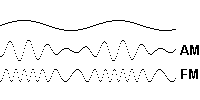Frequency modulation facts for kids
Imagine sending messages using invisible waves! Frequency modulation, or FM, is a clever way to send information, like music or voices, through the air. It works by changing how often a radio wave wiggles. This "wiggling speed" is called its frequency.
This method is different from amplitude modulation (AM). AM changes how tall the wave is, but keeps its wiggling speed the same. FM is very important for things like radio and other ways we send signals over long distances.
Contents
What is FM Radio?
When you listen to the radio, you're probably hearing FM. FM radio stations send out sounds using this special method. One big reason FM is popular is its amazing sound quality. If you compare FM music to AM music, FM usually sounds much clearer and richer.
Why FM Sounds Better
FM signals are great at ignoring noise. Think of it like this: if there's static or interference, AM signals pick up that extra noise easily. But FM signals are designed to mostly ignore those unwanted sounds. This means your music or talk show comes through much clearer.
How FM Waves Travel
Even though FM sounds better, its signals don't travel as far as AM signals. This is because FM uses higher frequencies. These higher-frequency waves don't bounce off a special layer in Earth's atmosphere called the Kennelly–Heaviside layer as well as AM waves do. So, AM can sometimes reach radios much further away, even if the sound isn't as perfect.
Using FM in Daily Life
Many radio stations use both AM and FM. They might use AM for talk shows or news, because it can cover a wider area. Then, they use FM for music, where good sound quality is really important.
Stereo Sound with FM
FM broadcasting often includes something called a "difference signal." This allows your home radio to create stereo sound. Stereo sound makes it seem like different sounds are coming from different places, like from two separate speakers. This makes music sound much more lifelike and exciting!
Images for kids
-
A signal may be carried by an AM or FM radio wave.
-
FM has better noise rejection than AM. This was shown in a 1940 demonstration by General Electric. With a million-volt electric arc causing interference, the AM radio only made static. But the FM radio clearly played music!
See also
 In Spanish: Frecuencia modulada para niños
In Spanish: Frecuencia modulada para niños






